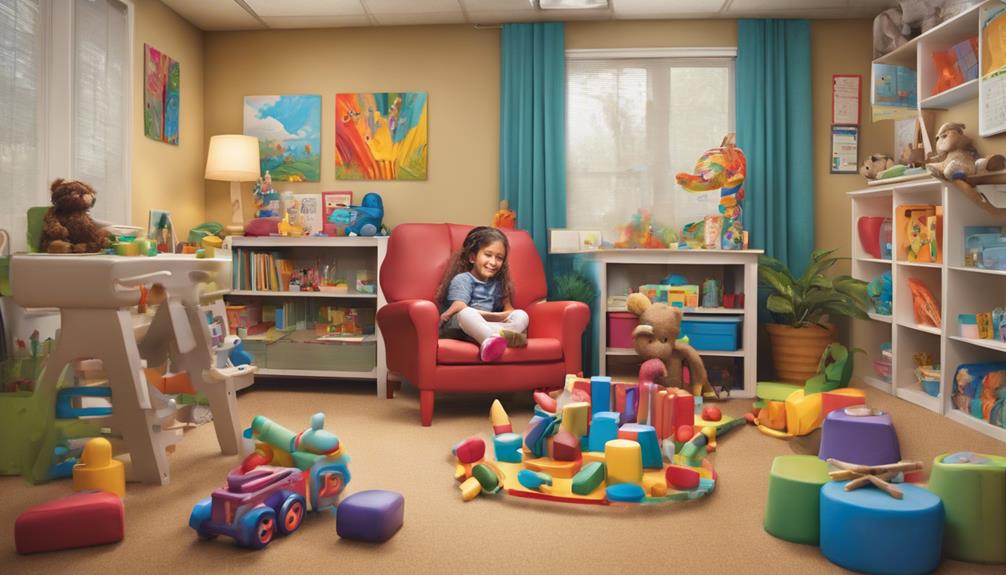Mastering the art of talking with our children means creating engaging dialogues that spark their imagination and nurture their growth. Let's ask open-ended questions, encouraging them to express their unique thoughts and develop problem-solving skills. We can foster creativity by discussing imaginative scenarios, using rich language to deepen their thinking. Creating a supportive environment with active listening, empathy, and validation builds trust and emotional safety. These conversations boost their confidence and self-esteem, making them feel valued and understood. To make these interactions truly meaningful, we need to focus on these essential techniques and principles to see significant growth.
Key Takeaways
- Ask open-ended questions to encourage creative thinking and deeper conversations.
- Actively listen by giving your full attention and using nonverbal cues.
- Create a supportive environment where your child feels emotionally safe and valued.
- Engage in imaginative discussions to spark creativity and problem-solving skills.
- Provide positive reinforcement and affirmations to build your child's confidence.
Importance of Engaging Dialogue
Engaging in meaningful dialogue with our children stimulates their imagination and critical thinking skills. When we take the time to have conversations with kids, we're not just talking; we're building a foundation for their cognitive and emotional development. Through these interactions, we support children by allowing them to explore their thoughts and ideas freely. This creates a supportive environment where they feel valued and heard, which is vital for their self-esteem and growth.
Having deeper conversations with our children also helps to strengthen our bond with them. It's more than just asking about their day; it's about genuinely listening and responding in a way that shows we care about what they're saying. These moments of connection can turn ordinary conversations into opportunities for nurturing their creativity and problem-solving abilities.
Moreover, engaging in imaginative discussions can lead to unexpected insights and ideas. When we talk to our kids about their dreams, stories, or hypothetical situations, we're encouraging them to think outside the box. This not only boosts their creativity but also enhances their ability to think critically and solve problems in innovative ways.
Essentially, meaningful dialogue is a powerful tool for developing well-rounded, confident individuals.
Asking Open-Ended Questions

By asking open-ended questions, we encourage our children to think deeply and express their thoughts more freely. This approach, recommended by experts from Harvard, is important when talking with children. Open-ended questions not only stimulate conversation but also help us gain insight into our child's thoughts and feelings. These types of questions promote critical thinking and foster a sense of curiosity and exploration.
Here are four reasons why open-ended questions are beneficial:
- Encourage Creativity: They allow children to express themselves in unique and imaginative ways, rather than giving one-word answers.
- Promote Problem-Solving: By thinking through their responses, children develop essential problem-solving skills.
- Enhance Communication: These questions lead to richer and more meaningful conversations, strengthening our bond with our children.
- Build Confidence: Children feel valued and heard when they can share their thoughts and ideas, boosting their self-esteem.
When we incorporate open-ended questions into our daily interactions, conversations help us connect on a deeper level. This practice not only nurtures our child's development but also enriches our relationship, creating a supportive and engaging environment for them to grow.
Encouraging Imaginative Discussions

We can spark our children's creativity by encouraging them to engage in imaginative discussions. By doing so, we're not just having fun; we're helping them develop essential skills. Speech pathologists often emphasize the importance of these interactive conversations, as they can greatly enhance a child's ability to think critically and express their ideas.
As parents and educators, it's crucial to ask open-ended questions that prompt children to explore their imagination. Instead of asking yes or no questions, we can ask, 'What would happen if animals could talk?' or 'How would you design a spaceship?' These types of questions inspire kids to think deeply and share their unique perspectives.
Creating a supportive environment is key. When children feel comfortable expressing themselves, they're more likely to engage in these imaginative discussions. We should listen actively and show genuine interest in their ideas, which helps them feel valued and understood.
Encouraging dialogue that sparks curiosity and wonder can lead to deeper connections with our children. It's not just about enhancing their communication skills; it's about helping them develop problem-solving abilities and a sense of creativity that will benefit them throughout their lives. By fostering these imaginative discussions, we're laying the groundwork for their future success.
Fostering Creativity in Conversations

Fostering creativity in conversations with our children starts by embracing their natural curiosity and encouraging them to explore new ideas. When we're talking with our kids, engaging them in ways that stimulate their creativity and imagination is crucial. One effective method is using rich talk techniques, which involve asking open-ended questions and encouraging imaginative scenarios.
Here are four ways we can foster creativity through our conversations:
- Ask Open-Ended Questions: Instead of yes-or-no questions, ask ones that require thought and elaboration. For example, 'What would happen if animals could talk?'
- Encourage Storytelling: Prompt them to create stories, allowing their creativity to flourish. Ask them to describe a day in the life of their favorite toy.
- Explore New Ideas Together: Engage in discussions about unusual or fantastical topics. This might be imagining what it would be like to live on another planet.
- Use Rich Talk Techniques: Use descriptive language and varied vocabulary to spark their imagination. This helps them think more deeply and creatively.
Creating a Supportive Environment

When we create a supportive environment, we encourage open communication and foster emotional safety for our children.
By actively listening and showing empathy, we build trust and make them feel valued and understood.
This nurturing atmosphere allows our children to express their thoughts and feelings freely, promoting their emotional well-being and strengthening our relationship with them.
Encourage Open Communication
Active listening, empathy, and validation are essential components in building a supportive environment that encourages open communication with your child. According to the Harvard Graduate School of Education's Center on the Developing Child, open communication is vital for your child's emotional and social development.
When we create an atmosphere where our children feel heard, understood, and valued, we pave the way for deeper connections and mutual respect.
To encourage open communication, we should focus on the following strategies:
- Active Listening: Give your full attention when your child is speaking. Put away distractions and make eye contact to show that you value what they're saying.
- Empathy: Try to understand their perspective and feelings. Acknowledge their emotions even if you don't necessarily agree with their viewpoint.
- Validation: Confirm their feelings and experiences without judgment. Simple affirmations like 'I understand why you feel that way' can go a long way.
- Consistent Availability: Make regular time for conversations. Let your child know you're always available to talk, whether it's during meals, car rides, or bedtime.
Foster Emotional Safety
Establishing a supportive environment where children feel emotionally safe is essential for their overall well-being and development. When young children know they can express emotions without fear of judgment, they're more likely to share their thoughts and feelings openly. This creates a foundation of trust, allowing our relationship with them to deepen and grow stronger.
Providing a safe space means actively listening to our children, validating their feelings, and reassuring them that it's okay to feel what they're feeling. By doing so, we encourage them to express emotions, knowing they'll be met with understanding and compassion. This emotional safety is vital for their development, as it helps them build resilience and equips them to handle life's challenges more effectively.
We should also be mindful of our reactions. Responding with empathy rather than frustration or dismissal fosters a secure environment. When children feel secure and supported, they thrive, becoming more confident and self-aware.
Let's create a home where open communication and emotional safety are the norms, ensuring our children feel protected and valued. This nurturing atmosphere won't only strengthen our bond but also promote their mental and emotional health.
Nurturing Confidence Through Talk

By engaging our children in meaningful conversations, we can greatly enhance their confidence and self-esteem. According to Harvard Medical School, when we talk openly with young kids, we help them feel less anxious and more secure. This sense of security is foundational for building confidence.
Here are four key ways to nurture confidence through conversation:
- Encourage Open-Ended Questions: Asking questions that don't have a right or wrong answer allows our children to think critically and express themselves freely. This practice boosts their problem-solving skills and confidence in their opinions.
- Provide Positive Reinforcement: Celebrate their ideas and efforts. Saying things like, 'I love how you thought about that!' reinforces their sense of self-worth and capability.
- Create a Safe Space for Dialogue: Make sure your child feels safe to share their thoughts without judgment. This environment empowers them to voice their opinions and feelings confidently.
- Use Affirmations: Regularly affirm their abilities and efforts. Simple statements like, 'You did a great job!' can significantly enhance their self-esteem.
Techniques for Active Listening

When we practice active listening, we show our children that their thoughts and feelings genuinely matter. This aspect of the Art of Talking is important for building a strong, trusting relationship. To master active listening, we need to give our full attention to our children, using nonverbal cues like eye contact, nodding, and appropriate facial expressions. These signals indicate that we're genuinely interested in their words.
Reflecting back what our child says is another key technique. By paraphrasing their statements, we confirm our understanding and encourage them to share more. Open-ended questions also play an essential role in delving deeper into their thoughts and feelings. Instead of asking 'Did you have a good day?', try 'What was the best part of your day?'
Practicing empathy is equally significant. Acknowledging and validating their emotions makes them feel heard and creates a safe space for expression. Here's a quick reference table for these techniques:
| Technique | Description |
|---|---|
| Full Attention | Focus entirely on your child, eliminating distractions. |
| Nonverbal Cues | Use eye contact, nodding, and facial expressions. |
| Reflect Back | Paraphrase their words to show understanding. |
| Open-ended Questions | Encourage detailed responses with thoughtful questions. |
| Empathy | Validate their feelings, showing you understand. |
Frequently Asked Questions
How to Teach Your Child the Art of Conversation?
To teach our child the art of conversation, we encourage them to ask questions and share thoughts, promoting active engagement.
We model good listening by maintaining eye contact and responding appropriately.
Practicing turn-taking helps them understand the importance of letting others speak.
Storytelling and imaginative play spark creativity and enhance communication skills.
We provide a supportive, non-judgmental environment for them to express themselves freely and develop conversational skills.
What Is the Art of Conversation for Children?
Imagine a world where every child's voice is heard and valued.
The art of conversation for children involves engaging them in meaningful dialogues, asking open-ended questions, and encouraging critical thinking.
It's about creating a supportive space where they feel safe to share their thoughts and emotions.
Through back-and-forth exchanges, we foster their cognitive development and communication skills, nurturing their confidence and ability to express themselves.
How to Effectively Communicate With Children?
To effectively communicate with children, we should ask open-ended questions that encourage them to share their thoughts and feelings.
Let's engage in imaginative discussions, fostering creativity, and always listen actively.
By creating a supportive, non-judgmental environment, children will feel comfortable expressing themselves.
Using back-and-forth exchanges deepens our conversations, promoting their cognitive development.
It's all about showing genuine interest and making them feel valued and understood.
How to Talk to Your Child so They Will Listen?
Imagine planting seeds in a garden; that's how we should talk to our children so they listen.
We need to use active listening, validate their feelings, and be mindful of our tone and body language.
By offering choices and involving them in decisions, we foster independence.
Patience and empathy are key, recognizing that effective communication takes time and effort.
Let's nurture our conversations to grow strong bonds and mutual understanding.
Conclusion
To sum up, mastering the art of talking with our children isn't just beneficial—it's the key to discovering a universe of connection and creativity.
By asking open-ended questions, fostering imaginative discussions, and actively listening, we create a supportive environment that nurtures their confidence.
Let's remember, our conversations can transform ordinary moments into extraordinary adventures.
Through engaging dialogue, we can truly make a world of difference in our children's lives, one word at a time.










